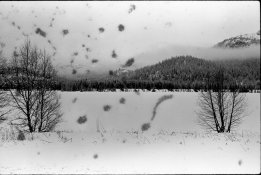newtonrings
Member
Hi,
I recently acquired a Kindermann stainless steel developing tank, for one 135 reel, with a 10 oz (~295 ml) volume. I tried it out today, developing a roll of Fomapan 100 that I've spooled myself from a 30.5 meter bulk-roll.
I always develop Fomapan 100 in Rodinal 1:50 and never had problems. The other negatives I've developed from this bulk-roll has been totally fine.
Info about this development:
I saw the marks on the negatives when I took the negs down after drying, and I thought that the culprit may be either air bobbles, sticking together or mold. After scanning and seeing the weird spots I'm just totally unsure of what this is. Appreciate any help!
I can't feel anything on either sides of the negatives, and with the naked eye it just looks like spots of lower density/transparent.
I recently acquired a Kindermann stainless steel developing tank, for one 135 reel, with a 10 oz (~295 ml) volume. I tried it out today, developing a roll of Fomapan 100 that I've spooled myself from a 30.5 meter bulk-roll.
I always develop Fomapan 100 in Rodinal 1:50 and never had problems. The other negatives I've developed from this bulk-roll has been totally fine.
Info about this development:
- Just under 6 mL of Rodinal
- Close to 290 mL of water
- 9 mins
- 20 degrees celsius
Stuff that was a first time for me:
- Getting 135 film onto a metal reel - had no issue as far as I can tell. If this problem is due to film sticking together it obviously was an issue

- Using the new tank, pouring, agitating, etc (I regularly use about 3-4 different tanks with plastic reels, and I've developed I guess about 100 rolls of 135 and 120 in both color and bw with a myriad of developers)
I saw the marks on the negatives when I took the negs down after drying, and I thought that the culprit may be either air bobbles, sticking together or mold. After scanning and seeing the weird spots I'm just totally unsure of what this is. Appreciate any help!
I can't feel anything on either sides of the negatives, and with the naked eye it just looks like spots of lower density/transparent.






 .
. 